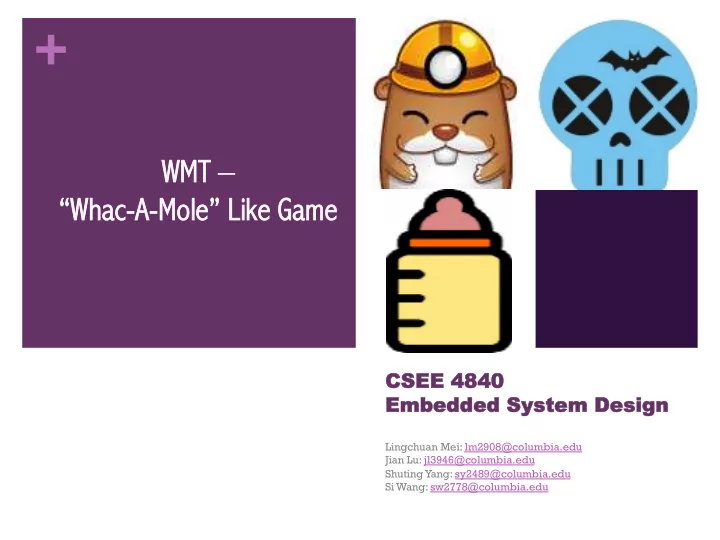

+ WMT – – “Wh Whac ac-A-Mole” Li Like G Game me CSEE 4840 4840 Embed mbedded ded System em Des esign ign Lingchuan Mei: lm2908@columbia.edu Jian Lu: jl3946@columbia.edu Shuting Yang: sy2489@columbia.edu Si Wang: sw2778@columbia.edu
+ Overview n “Whac-A-Mole” like game system
+ Basic Game Logic n Nine holes, Three initial lives, Two minutes n Different items Get: Good! Add life Deduct life Miss: Deduct life Nothing happen Nothing happen n Different levels
+ Basic Game Logic Cont.
+ System Architecture
+ Hardware Implementation n Work with ADC to get the touch position x and y coordinates and read it out in Nios II n Figure out how to display image correctly on a 800x480 screen n Turn the x,y coordinates into useful data for software processing. n Set up the interrupt for touching n Figure out how to store all the data on board, basically using SDRAM and SRAM together. Using SRAM MUX.
+ Hardware Implementation Cont. n Map all the peripherals onto Avalon bus and get rid of the ELF error n Image conversion n Create the state machine for the game n Redesign a LED clock on the touch screen.
+ Lessons Learned About Hardware n ELF error is usually due to wiring mistake in the top level connection of NIOS. n Every time you copy an entire project, remember to recreate the nios project. Otherwise the BSP package is mapped to the old SOPC. n Should have design the interface more easy to use. Should split all the variables instead of putting all of them together n Build the design using small modules.
+ Display Dynamic Items n Image -> Matrix -> Calculate the edge of the item -> SRAM n Get the signal from the software: when, where, what n Layers implementation
+ Software n Get touch signal from hardware and identify the corresponding action n Control the difficulty level n Implement of the main game logic n Keep track of the lives left, points earned and the action user take n Send signal back to the hardware
+ Audio Music.h Main.c SDRAM CPU SDRAM controller Avalon Bus N ios q r I System Music controller Ear plugs Irq WM8731 De2_WM8731 Audio _audio CODEC
+ Design Key Issues n 1.Understand how WM8731 works n 2.Tried to synthesis music. -Too simple n 3.Sample rates. 22050Hz. -killed 6000hz n 4.Store music in ROM. -slow compilation
+ Design Key Issues f = NIOS 4. Data transfer 50MHZ IRQ f = 18.432MHZ Through Avalon Bus using RAM 256-2bytes interrupt request. Data_out 256-2bytes Using buffer to buffer data transfer between clock domains Shift_out 2 bytes Audio_chip
+ Design Key Issues 5. Structure Optimize
+ Design Key Issues 5. Structure Optimize
+ Design Key Issues 5. Structure Optimize
+ Design Key Issues 5. Structure Optimize
+ Design Key Issues 5. Structure Optimize
+ Design Key Issues 5. Structure Optimize
+ Design Key Issues 6. Merge music and sound effect Audio = (Music + Sound)/2 Audio = Music* 1/4 + Sound * 3/4
+ Lessons learned n Hands on experience of embedded system – interesting but time consuming n Debug skill (both hardware and software) n Always prepare a back up plan for big events. J
+ Acknowledgement n We WMT team would thank dear Prof. Stephen A. Edwards and dear Professor David Lariviere for all the professional instructions and kindly help. n At last, we really appreciate the hard work of the TAs. Thank you so so much!
+ Demonstration n Watch the video or play the game???
Recommend
More recommend